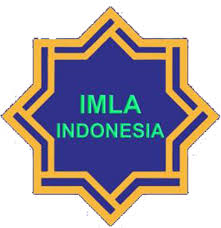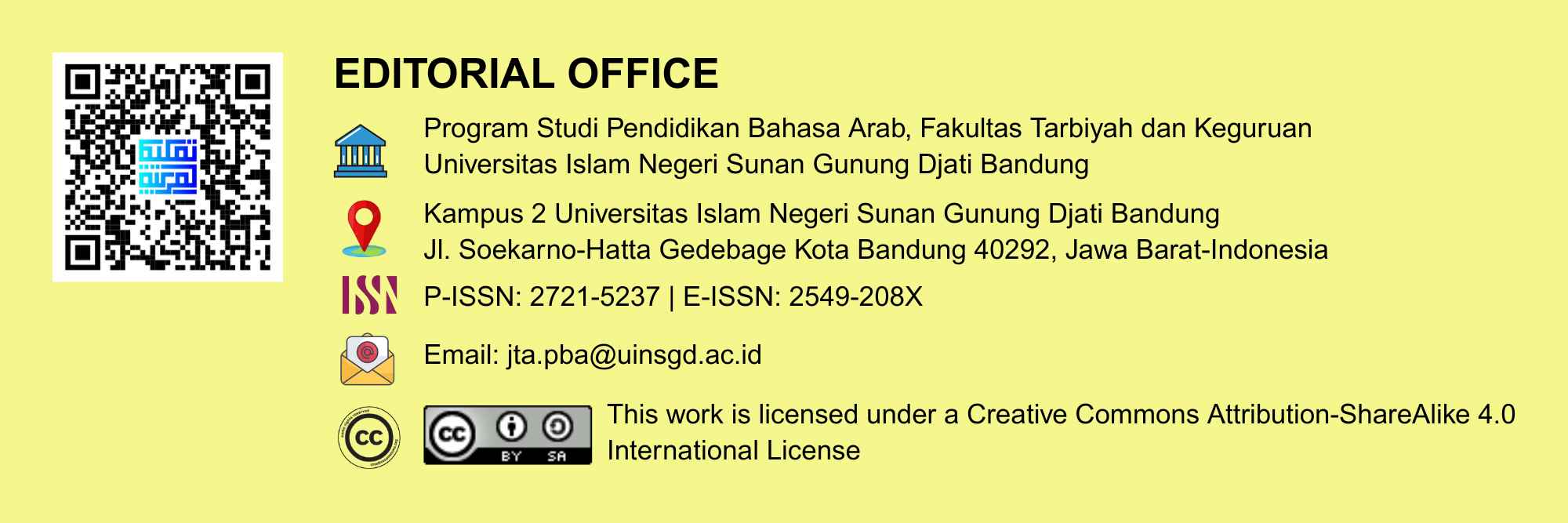The Influence of the Bengkulu Local Language Interference on Arabic Speaking Skills
DOI:
https://doi.org/10.15575/jta.v9i1.45347Keywords:
Arabic speaking skills, Bengkulu local language, Interference, Language teaching strategies, Phonetic Interference, Second language acquisitionAbstract
This study explores the impact of Bengkulu local language interference on the speaking skills of students learning Arabic at MAN Islam Cendekia Bengkulu. While language interference in second language acquisition is well-documented, there is limited research on the influence of regional languages, such as Bengkulu, in the Southeast Asian educational context. Using a qualitative approach, this study involved interviews and classroom observations of 30 students to identify patterns of Interference in Arabic pronunciation, sentence structure, and vocabulary. The findings revealed significant phonetic similarities between Bengkulu and Arabic, with local language phonetics contributing to noticeable speech errors, particularly in consonant articulation and sentence construction. These errors were linked to specific characteristics of the Bengkulu language, which affect the student's ability to produce Arabic sounds and structures accurately. The study emphasizes the need for targeted strategies to address language interference in Arabic language teaching. It recommends adjustments in curriculum design and teaching methods to help mitigate the impact of local language interference, ultimately improving students' Arabic proficiency. The implications of this research extend to teacher training and materials development, urging educators to incorporate contrastive linguistic analysis and oral drills that directly target problematic phonetic and syntactic areas. Future studies are encouraged to examine interference effects across other local Indonesian languages and explore longitudinal changes in student performance following targeted instructional interventions.
References
Abourehab, Y., & Azaz, M. (2023). Pedagogical Translanguaging in Community/Heritage Arabic Language Learning. Journal of Multilingual and Multicultural Development, 44(5), 398–411. https://doi.org/10.1080/01434632.2020.1826496
Alahmadi, A., & Foltz, A. (2020). Effects of Language Skills and Strategy Use on Vocabulary Learning Through Lexical Translation and Inferencing. Journal of Psycholinguistic Research, 49(6), 975–991. https://doi.org/10.1007/s10936-020-09720-9
Alamsyah, A. (2018). Local Language, Bahasa Indonesia, or Foreign Language? Proceedings of the 1st International Conference on Intellectuals’ Global Responsibility (ICIGR 2017), 125, 61–66. https://doi.org/10.2991/icigr-17.2018.15
Alisoy, H. (2024). Exploring Language Acquisition: The Role of Native Language Interference in ESL Learners. Journal of Azerbaijan Language and Education Studies, 1(1), 50–66. https://doi.org/10.69760/jales.2024.00105
Alshammari, A. R. (2023). Analyzing Word Order Variation and Agreement Asymmetry in SVO and VSO Structures of Standard Arabic: Towards a Unified Account. Cogent Arts & Humanities, 10(2), 2268920. https://doi.org/10.1080/23311983.2023.2268920
Amengual, M. (Ed.). (2024). The Cambridge Handbook of Bilingual Phonetics and Phonology (1st ed.). Cambridge University Press. https://doi.org/10.1017/9781009105767
Ardiansyah, A., Sahrani, S., & Izzati, D. (2024). Arabic Interference in Manuscript of Hadza Kitab Mujarrobat: A Study of Arabic Philology and Sociolinguistics. Arabiyatuna: Jurnal Bahasa Arab, 8(1), 347–372. https://doi.org/10.29240/jba.v8i1.9496
Asadi, I. A. (2019). How the Characteristics of Phonemes and Syllabic Structures Can Impact the Phonological Awareness of Kindergarten and First-Grade Arabic-Speaking Children. Reading Psychology, 40(8), 768–781. https://doi.org/10.1080/02702711.2019.1674431
Barone, S. (2024). The Importance of Interlanguage in Language Teaching: An Analysis of its Development in l2 Learners. Vestnik of Samara State Technical University Psychological and Pedagogical Sciences, 21(3), 81–97. https://doi.org/10.17673/vsgtu-pps.2024.3.6
Barrett, T., Trosky, A., & Tawadrous, A. (2018). Transforming Cultural Conflict in the Foreign Language Classroom: The Case of Arabic at Defense Language Institute. Pedagogy, Culture & Society, 26(1), 123–139. https://doi.org/10.1080/14681366.2017.1363809
Desmottes, L., Maillart, C., & Meulemans, T. (2017). Memory Consolidation in Children with Specific Language Impairment: Delayed Gains and Susceptibility to Interference in Implicit Sequence Learning. Journal of Clinical and Experimental Neuropsychology, 39(3), 265–285. https://doi.org/10.1080/13803395.2016.1223279
Dumawa, D. B. (2025). Syntactic Analysis of the Written Discourse of Non-Language Learners. International Journal of Research Studies in Education, 14(8), 15–32. https://doi.org/10.5861/ijrse.2025.25058
Fahri, M., Arrahman, F. P., Albantani, A. M., Mahfuzo, M. R., & Muslimin, M. I. (2024). Investigating the Validity and Reliability of WTC Construct In L2 Arabic: A Case Study. Ta’lim al-’Arabiyyah: Jurnal Pendidikan Bahasa Arab & Kebahasaaraban, 8(1), 1–17. https://doi.org/10.15575/jpba.v8i1.35023
Gass, S., Loewen, S., & Plonsky, L. (2021). Coming of Age: The Past, Present, and Future of Quantitative SLA Research. Language Teaching, 54(2), 245–258. https://doi.org/10.1017/S0261444819000430
Gmelin, J.-O. H., & Kunnen, E. S. (2021). Iterative Micro-Identity Content Analysis: Studying Identity Development within and across Real-Time Interactions. Identity, 21(4), 324–340. https://doi.org/10.1080/15283488.2021.1973474
Goncalves, M., Hu, Y., Aliagas, I., & Cerdá, L. M. (2024). Neuromarketing Algorithms’ Consumer Privacy and Ethical Considerations: Challenges and Opportunities. Cogent Business & Management, 11(1), 2333063. https://doi.org/10.1080/23311975.2024.2333063
Hasyim, M. Y. A. (2025). The Role of Negative Transfer in the Arabic Language Acquisition of Indonesian Learners. In C. D. M. Putri, A. Mustofa, W. Hakim, G. Pradana, & D. Tandyonomanu (Eds.), Proceedings of the International Joint Conference on Arts and Humanities 2024 (IJCAH 2024) (Vol. 879, pp. 1102–1112). Atlantis Press SARL. https://doi.org/10.2991/978-2-38476-317-7_107
Hilmi, D., Toifah, N., & Sa’diyah, H. (2024). Linguistic Intelligence in Arabic Learning in Islamic Religious College Students. Ta’lim al-’Arabiyyah: Jurnal Pendidikan Bahasa Arab & Kebahasaaraban, 8(2), 87–101. https://doi.org/10.15575/jpba.v8i2.37714
Ingram, D., & Babatsouli, E. (2024). The Handbook of Clinical Linguistics, Secon Edition. In Cross Linguistic Phonological acquisition. John Wiley & Sons, Ltd. https://doi.org/10.1002/9781119875949.ch29
Jadue Roa, D. S. (2017). Ethical Issues in Listening to Young Children in Visual Participatory Research. International Journal of Inclusive Education, 21(3), 332–345. https://doi.org/10.1080/13603116.2016.1260829
Kang, O., Thomson, R. I., & Moran, M. (2018). Empirical Approaches to Measuring the Intelligibility of Different Varieties of English in Predicting Listener Comprehension. Language Learning, 68(1), 115–146. https://doi.org/10.1111/lang.12270
Khasawneh, N. A. S., & Khasawneh, M. A. S. (2022). Linguistic Needs of Non-Native Students of Arabic Language at Saudi Universities. International Journal of Language Education, 6(3), 245–253. https://doi.org/10.26858/ijole.v6i3.2162
Kirkpatrick, A., & Liddicoat, A. J. (2019). The Routledge International Handbook of Language Education Policy in Asia (A. Kirkpatrick & A. J. Liddicoat, Eds.; 1st ed.). Routledge. https://doi.org/10.4324/9781315666235
Klaus, J., Lemhofer, K., & Schriefers, H. (2018). The Second Language Interferes with Picture Naming in the First Language: Evidence for L2 Activation During L1 Production. Language, Cognition and Neuroscience, 33(7), 867–877. https://doi.org/10.1080/23273798.2018.1430837
Lee, H. Y., Hamid, M. O., & Hardy, I. (2023). Language and Education Policies in Southeast Asia: Reorienting Towards Multilingualism-as-Resource. International Journal of Multilingualism, 20(3), 1106–1124. https://doi.org/10.1080/14790718.2021.2002333
Maryani, N., Ardiansyah, A. A., & Hasan, A. M. (2024). Arabic Language Learners as an Example of Their Willingness to Communicate in a Second Language (L2-WTC) Accomplishment. Jurnal Al Bayan: Jurnal Jurusan Pendidikan Bahasa Arab, 16(2), 463–479. https://doi.org/10.24042/albayan.v16i2.24312
McManus, K. (2021). Cross-linguistic Influence and Second Language Learning. Routledge.
McManus, K., & Marsden, E. (2019). Using Explicit Instruction About L1 to Reduce Cross-linguistic Effects in L2 Grammar Learning: Evidence from Oral Production in L2 French. The Modern Language Journal, 103(2), 459–480. https://doi.org/10.1111/modl.12567
Md Zolkapli, R. B., & Salehuddin, K. (2019). Lexical Access Patterns of Second Language Speakers of English. GEMA Online Journal of Language Studies, 19(4), 48–65. https://doi.org/10.17576/gema-2019-1904-03
Mirzayev, E. (2024). The Influence of First Language Interference on ESL Writing Skills. EuroGlobal Journal of Linguistics and Language Education, 1(1), 33–39. https://doi.org/10.69760/ds5gc908
Muna, Z. T., Fadhilah, F. N., Rachmawati, A. E., & Setiyawan, A. (2024). Exploring Challenges in Learning Arabic as a Second Language: A Study of Code-Switching and Code-Mixing. Ta’lim al-’Arabiyyah: Jurnal Pendidikan Bahasa Arab & Kebahasaaraban, 8(1), 103–116. https://doi.org/10.15575/jpba.v8i1.32905
Nana Gassa Gonga, A., Crasborn, O., & Ormel, E. (2024). Interference: A Case Study of Lexical Borrowings in International Sign Interpreting. International Journal of Multilingualism, 21(1), 169–188. https://doi.org/10.1080/14790718.2022.2074999
Robbani, A. S., & Zaini, H. (2022). Interferensi Bahasa Sasak terhadap Bahasa Arab Santri. Diglosia: Jurnal Kajian Bahasa, Sastra, Dan Pengajarannya, 5(2), 317–326. https://doi.org/10.30872/diglosia.v5i2.347
Robertson, M., Macdonald, S., Starks, D., & Nicholas, H. (2018). Enabling Change in EFL Teachers’ Ideologies about Grammar and Grammar Teaching Through Alternative Pedagogies. System, 72(1), 75–84. https://doi.org/10.1016/j.system.2017.11.002
Rohmah, Z., Sholihah, D. N., Basthomi, Y., & Milal, A. D. (2024). School-Scape as a Linguistic Battlefield: An LL Study at Darussalam Education Complex of Gontor, Indonesia. Cogent Arts & Humanities, 11(1), 2348301. https://doi.org/10.1080/23311983.2024.2348301
Rustinar, E. (2018). Clitic -lah in Constructing Swear of Bengkulu-Malay Language. Proceedings of the Sixth International Conference on Languages and Arts (ICLA 2017), 148, 175–179. https://doi.org/10.2991/icla-17.2018.30
Sato, M., & Tanaka, S. (2014). Core and Networking in L2 Lexical Teaching in an Input-Poor Context. Open Journal of Modern Linguistics, 04(05), 676–686. https://doi.org/10.4236/ojml.2014.45058
Sholihah, N. (2020). Interferensi Gramatikal Bahasa Indonesia Dalam Percakapan Berbahasa Arab Santri PTYQM Kudus. LISANUNA: Jurnal Ilmu Bahasa Arab Dan Pembelajarannya, 9(2), 309–326. http://dx.doi.org/10.22373/ls.v9i2.6749
Sulaiman, N. A., Salehuddin, K., & Khairudin, R. (2020). Reading English Academic Texts: Evidence from ESL Undergraduates’ Eye Movement Data. 3L The Southeast Asian Journal of English Language Studies, 26(1), 60–78. https://doi.org/10.17576/3L-2020-2601-05
Syafei, I., Ardiansyah, A. A., & Nafsi, Z. (2020). Analisis Kontrastif Proses Afiksasi Pada Verba dalam Bahasa Arab dan Bahasa Minangkabau. Metalingua: Jurnal Penelitian Bahasa, 18(2), 225-237. Retrieved from http://metalingua.kemdikbud.go.id/jurnal/index.php/metalingua/article/view/480.
Twis, M. K., Miller, V. J., Cronley, C., & Fields, N. (2020). Collecting Qualitative Data Through Mobile Applications: A Multiple Case Study Report. Journal of Technology in Human Services, 38(1), 38–53. https://doi.org/10.1080/15228835.2019.1599766
Wahyudin, D., Karim, A., & Solehah, M. (2024). Phonological Errors in Reciting the Quran among Madrasah Diniyyah Students: Identifying Sources and Solutions. Ta’lim al-’Arabiyyah: Jurnal Pendidikan Bahasa Arab & Kebahasaaraban, 8(1), 132–145. https://doi.org/10.15575/jpba.v8i1.34806
Wilson, C., & Kim, E. S. (2021). Qualitative Data Collection: Considerations for People with Aphasia. Aphasiology, 35(3), 314–333. https://doi.org/10.1080/02687038.2019.1693027
Xiong, Y. (2025). Translanguaging in Spanish World Language Classrooms: US Secondary School Teachers’ Reported Practices and Perceptions. International Journal of Multilingualism, 23(1), 1–24. https://doi.org/10.1080/14790718.2025.2485184
Yu, Q., & Li, Q. (2025). Cross-Linguistic Influence in Third Language Acquisition: Evidence from Refusal Strategies of Uyghur–Mandarin–English Trilinguals. International Journal of Multilingualism, 26(1), 1–18. https://doi.org/10.1080/14790718.2025.2470467
Yussof, N. T., & Sun, H. (2020). Mismatches Between Teacher Beliefs, Practices and Reasons for English Use in Preschool Malay Language Classrooms. Language and Education, 34(4), 363–382. https://doi.org/10.1080/09500782.2020.1720230
Zulharby, P., Rafli, Z., & Setiadi, S. (2022). Interferensi Morfologi Bahasa Pertama terhadap Keterampilan Berbicara Bahasa Arab. Diglosia: Jurnal Kajian Bahasa, Sastra, Dan Pengajarannya, 5(4), 749–762. https://doi.org/10.30872/diglosia.v5i4.510
Downloads
Additional Files
Published
How to Cite
Issue
Section
Citation Check
License
Copyright (c) 2025 Falahun Ni'am, M Hidayaturrahman, Khosi'in Khosi'in, Nur Hidayat, Mekki Klaina

This work is licensed under a Creative Commons Attribution-ShareAlike 4.0 International License.
Authors who publish in Ta'lim al-'Arabiyyah: Jurnal Pendidikan Bahasa Arab dan Kebahasaaraban agree to the following terms:
- Authors retain copyright and grant the journal right of first publication with the work simultaneously licensed under a Creative Commons Attribution-ShareAlike 4.0 International (CC BY-SA 4.0) License that allows others to share the work with an acknowledgment of the work's authorship and initial publication in this journal.
- Authors are able to enter into separate, additional contractual arrangements for the non-exclusive distribution of the journal's published version of the work (e.g., post it to an institutional repository or publish it in a book), with an acknowledgment of its initial publication in this journal.
- Authors are permitted and encouraged to post their work online (e.g., in institutional repositories or on their website) prior to and during the submission process, as it can lead to productive exchanges, as well as earlier and greater citation of published work (See The Effect of Open Access).
![]()
Ta'lim al-'Arabiyyah: Jurnal Pendidikan Bahasa Arab dan Kebahasaaraban is licensed under a Creative Commons Attribution-ShareAlike 4.0 International License.
Based on a work at https://journal.uinsgd.ac.id/index.php/Talim







